Cold Processed Biodiesel Glycerin Bar Soap Kit
Video available at www.knicenclean.com/videos.html.
Your Knice-N-Clean soap kit should have come with everything shown here.
- Safety Glasses
- Rubber Gloves
- Thermometer
- Soap Mold Liner
- Knice-N-Clean fatty Acid Mix
- Sodium Based Biodiesel Glycerin
- Sodium Hydroxide (NaOH)
- Shipping Box
Warning: Sodium Hydroxide is a dangerous chemical and should be used with caution. Gloves and eye protection should always be worn whenever working with Sodium Hydroxide.
Note: Be sure you have followed the directions for building the shipping box soap mold or another suitable soap mold ready.

Additional items needed.
- 3-5 Gallon Container for Mixing the Soap
- Container to Mix the Caustic Solution
- Mixing Utensils
- Immersion Blender
- Slab Cutter or Knife
- Bar Cutter or Knife
- 32oz Distilled Water
- 3oz Scent (optional)
Note: All utensils and equipment should be stainless steel, glass, plastic or wood.
Note: NEVER USE ALUMINIUM!!!

Place your glycerin in your soap making container and slowly heat the glycerin at medium heat until it reaches 170°F.
Note: Soap making container should be stainless steel, glass or ceramic.
Note: NEVER USE ALUMINIUM!!!

Add the fatty acid mixture and stir them into the glycerin.
Allow the fatty acids to melt into the glycerin while keeping the temprature between 170°F and 180°F.
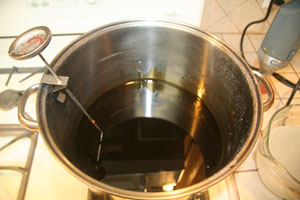
Once the fatty acid have melted turn off the heat.
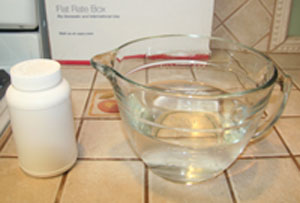
Before mixing the caustic solution be sure you are wearing your rubber gloves and glasses that came with your kit.
Measure 28oz - 30oz distilled water.
Note: Be sure to have vinegar on hand in case of any spilage of the caustic solution.
Note: Never use aluminium utensils or container when mixing the caustic solution.
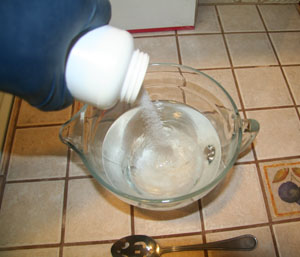
Slowly add the lye that came with your kit into the distilled water while stirring.
Note: Allways add the lye to the distilled water never the other way around.
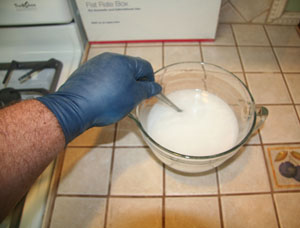
Stir until the lye is completely dissolved.
Note: Try not to breath the steam from the caustic solution as you stir.
Note: The caustic solution will be very hot.
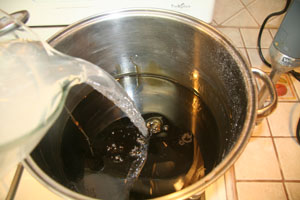
Slowly add the caustic solution to the melted glycerin while stirring.
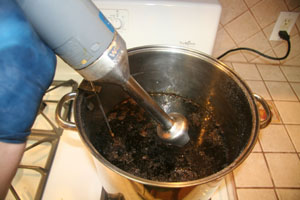
Mix until you notice trace.
An immersion blender greatly speed saponification and the soap will trace more quickly.
Trace is indicated by a thickening of the soap. A dribble of soap on top of the soap mixture will take a moment to mix back into the soap mixture.
Note: There may be a foam that forms on the top of the soap. You can use a slotted spoon to remove the foam. Put this into another small mold, it floats! The kids will love it!
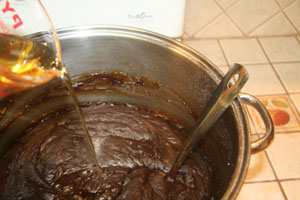
Slowly add 3oz of sent to the soap while stirring to encorporate the scent into the soap.

Pour the soap slowly and evenly into the prepared mold.
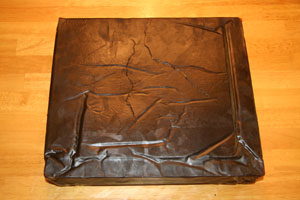
Allow the soap to harden for 8 to 10 hours.

Unmold the soap and mark a grid on the soap.
Mark the soap lenghtwise. You should be able to get 4 3 3/8" logs.
Mark the soap widthwise at 3/4" to 1". You should be able to 10-12 bars per log.
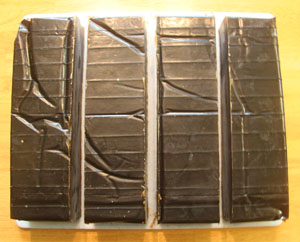
Cut the slab into 3 3/8" logs.
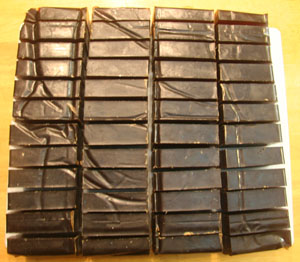
Cut the logs into 3/4" or 1" bars.

You should now have 48 - 52 bars of soap.
The soap will need to cure for 2 - 4 weeks or until it's no longer caustic hot. During this time the soap will also get harder as the excess water evaporates.
Note: Prior to using the soap it should be tested to ensure it is not caustic hot. This can be done with the battery test, pH strips or a pH meter.
Note: The battery test is a quick and easy way to test the soap. Simply touch the soap to your tongue. If it bites like a 9V battery the soap is still caustic hot and should be allowed more curing time.